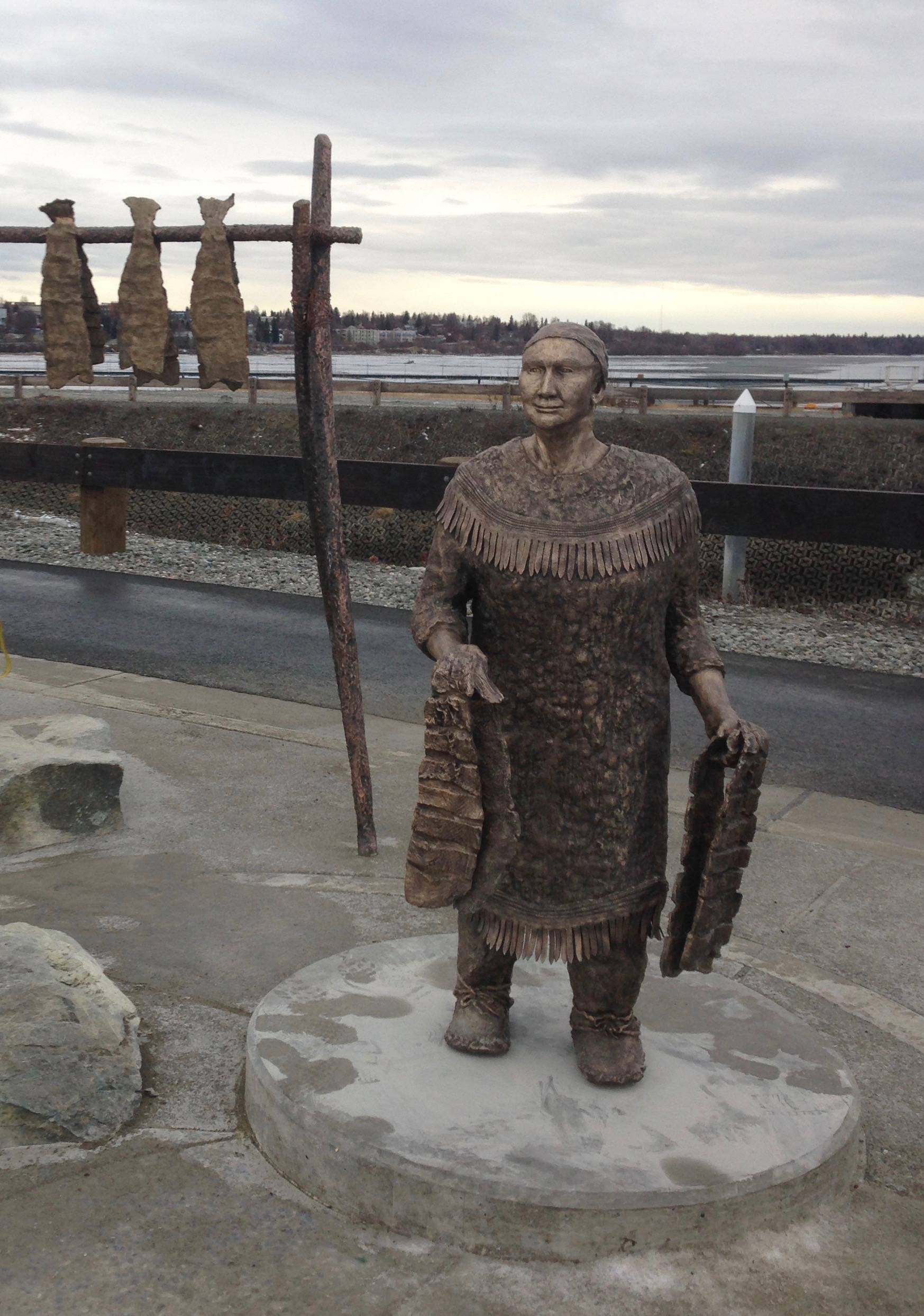Near Anchorage’s Ship Creek, a new bronze statue of an elder named Olga, a Dena’ina matriarch from the village of Eklutna, stands and overlooks land that was once a prosperous Native fish camp.
Soldotna artist Joel Isaak, who is Dena’ina himself, worked on the statue for two and a half years. He said he doesn’t take the opportunity to represent his culture through art lightly.
“It’s a lot of reflection,” Isaak said. “Trying to consolidate the history of cultural annihilation and assimilation in a positive light is tricky. It’s a way to convey that we are still living people.”
Isaak, a Dena’ina language professor at the Kenai Peninsula College, created his proposal for the statue after the village of Eklutna sent out a call for art. The parameters of the project included a piece that was in the likeness of Olga and that it tiedinto the fishing heritage at the site of Ship Creek.
Isaak said it’s always a rare opportunity to himself as an Alaska Native in public art.
“Most of the figurative work, if it is of indigenous people, looks like European people,” Isaak said. “I don’t identify with it from a visual standpoint. Being able to have the opportunity to be able to be a little more in control of the narrative is an honor. It’s exciting to see other people’s excitement at that opportunity.”
Isaak’s work can be found in many places across Alaska. He worked on a beluga whale diorama in Anchorage’s Ted Stevens Airport. Art of Isaak’s can be found in the Sheldon Jackson Museum in Sitka. Locally, Isaak completed statues in front of the Dena’ina Wellness Center and salmon skin bowls in the Kenai Courthouse.
Isaak had two photographs of Olga to base his statue on. The statue has Olga in customary Dena’ina clothing, like fish skin boots and a dress featuring quill work. Isaak said Dena’ina regalia has been important to him to him from an early age.
“Part of my journey in making the bronze statuary is learning how to make the clothing,” Isaak said. “I’ve wanted to learn to make regalia since I was in either first or second grade making paper pilgrim and Indian costume stuff. I researched at museums, and took workshops and learned all the methods needed to produce that clothing so I understood what I was trying to replicate before just looking at a picture in a book and trying to make it look something like that.”
The Dena’ina culture is a matriarchal society. Olga was an elder and a leader in Dena’ina land north of Anchorage. Isaak said the piece was not only honoring Dena’ina history and heritage, but also women in our society.
“Honoring our indigenous women and women everywhere — our society is based off of that model so there’s strong precedent for making an elder and then having the elder be a woman,” Isaak said. “I think it’s poignant in our current situation for the need to honor and respect women in our state and in the world, but especially with the current statistics. Bringing a visual voice to honor the role that women have in our society and culture.”
Born and raised in Soldotna, Isaak has many connections to Dena’ina culture, and even Olga herself. His family comes from the Upper Cook Inlet area in Point Possession. He said he’s distantly related to Olga, going back several generations.
“I’ve always had a strong desire to be connected to my indigenous Native culture and all the different cultures that my family comes from,” Isaak said. “But living here in Soldotna on Dena’ina land there has been a very strong desire from me from a very early age to learn my language and material culture.”
In Dena’ina culture, clothing is used as fine art. Dena’ina people were semi-nomadic or sedentary and would move between summer fish camp and a winter village, which was sometimes in almost the same spot, Isaak said. For this reason, art would move with the people in the form of clothing, which would represent things like where a person was from and what family they belonged to.
“You put (your art) on your clothing and you bring it with you,” Isaak said. “So the quill work design in the shape of the tunic can tell where you’re from — it can tell your clan information. It’s a form of visual written communication that we don’t really have that Rosetta Stone for. It served as a function for that and it also brings in that visual fine art. We just brought it with us everywhere instead of leaving it behind glass or in a frame.”
The statue is near Anchorage’s downtown, which a busy and growing part of the city. Isaak said the statue is a reminder of the area’s past.
“Having it be in Anchorage is making invisible people visible,” Isaak said. “It’s surrounded by this growing city, but we’re still here and making that visual presence.”

